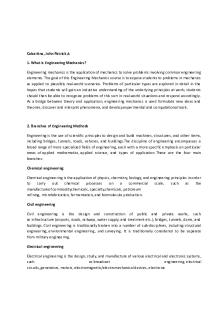Bilingual Assignment: Definition of terms PDF

| Title | Bilingual Assignment: Definition of terms |
|---|---|
| Author | Chelsea Rojas |
| Course | Foundations Of Bilingual & Multicultural Education: Theory & Practice |
| Institution | Adelphi University |
| Pages | 2 |
| File Size | 61.1 KB |
| File Type | |
| Total Downloads | 104 |
| Total Views | 155 |
Summary
Assignment focused on definition of terms: linguicism and subtractive/additive bilingualism from lectures and noted. Received grade of A...
Description
2-20-18 Definition of terms Linguicism? Linguicism is a term that means discrimination based on language or dialect. It has even been linguistically argued as racism. Phillipson (1992) describes linguicism as―ideologies, structures, and practices which are used to legitimate, effectuate, and reproduce an unequal division of power and resources (both material and immaterial) between groups which are defined on the basis of language (p. 47). Phillipson (1992) identified a power structure in the education system through linguicism where the students’ first language or mother tongue come from an immigrant or indigenous background are not given importance. Linguicism can be found across the country and institutions. It is especially seen in inner city schools, where teachers can perpetuate linguicism by stigmatizing the dialect spoken locally, for example, African American Vernacular. This is a form of structural power imbalance, which is a form of racism. Linguicism highlights and encourages the dominant language for its attractive characteristics, which in the U.S is English. Linguicism can also be perpetuated in a conscious or unconscious manner. Additive bilingualism and subtractive bilingualism? Subtractive bilingualism and additive bilingualism are the two main views that individuals usually have towards bilingualism. According to Baker (2011), when there is pressure to replace or demote the first language of immigrants, a subtractive form of bilingualism can occur. Subtractive bilingualism is the perception that the acquisition of the second language (L2) would be detrimental to a person’s first language (L1). This phenomenon has been experienced by minority groups, especially when they are not affirmed in their L1 or taught it correctly (Lambert, 1974). With the frequent usage of their L2, their L1 competence and culture are eventually replaced by the L2. Additive bilingualism however, believes that the acquisition of L2 is not detrimental to one’s L1, but that it is in fact, beneficial to the language user. The term “additive” describes the addition that occurs when a person adds another language to their skillset. This means that even while learning a second language, an individual’s first language skills and culture are still valued. Having an additive bilingual environment and culture is the main goal of bilingual education and it occurs when one is proficient in both the cognitive-academic aspect and communication in both their L1 and L2 (Lambert, 1974). Total additive bilingualism is said to be achieved once an individual is consistently able to hold on to and have a positive mentality towards their L1 culture while also having the same attitude towards their L2 (Baker, 2011).
References Baker, C. (2011). Foundations of bilingual education and and bilingualism (5th ed.).
Multilingual matters. Pg. 75-76 Lambert, W.E. (1974). Culture and language as factors in learning and education. In F. E. Abour & R.D.Meade(Eds.), Cultural factors in learning and education(pp.91-122). Bellingham, Washington: 5th Western Washington Symposium on Learning. Google Scholar Phillipson, R. (1992). Linguistic Imperialism. New York: Oxford University Press....
Similar Free PDFs

Bilingual codeswitching
- 5 Pages

Bilingual Task - ESSAY
- 4 Pages

Chapter 7 Terms Assignment
- 1 Pages

Definition of Statistics
- 5 Pages

Definition of Physical Education
- 3 Pages
Popular Institutions
- Tinajero National High School - Annex
- Politeknik Caltex Riau
- Yokohama City University
- SGT University
- University of Al-Qadisiyah
- Divine Word College of Vigan
- Techniek College Rotterdam
- Universidade de Santiago
- Universiti Teknologi MARA Cawangan Johor Kampus Pasir Gudang
- Poltekkes Kemenkes Yogyakarta
- Baguio City National High School
- Colegio san marcos
- preparatoria uno
- Centro de Bachillerato Tecnológico Industrial y de Servicios No. 107
- Dalian Maritime University
- Quang Trung Secondary School
- Colegio Tecnológico en Informática
- Corporación Regional de Educación Superior
- Grupo CEDVA
- Dar Al Uloom University
- Centro de Estudios Preuniversitarios de la Universidad Nacional de Ingeniería
- 上智大学
- Aakash International School, Nuna Majara
- San Felipe Neri Catholic School
- Kang Chiao International School - New Taipei City
- Misamis Occidental National High School
- Institución Educativa Escuela Normal Juan Ladrilleros
- Kolehiyo ng Pantukan
- Batanes State College
- Instituto Continental
- Sekolah Menengah Kejuruan Kesehatan Kaltara (Tarakan)
- Colegio de La Inmaculada Concepcion - Cebu










